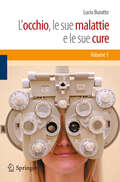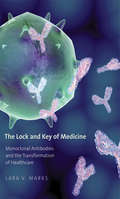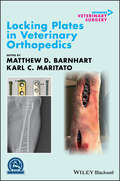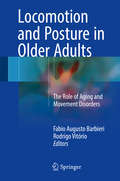- Table View
- List View
Locating Medical History: The Stories and Their Meanings
by John Harley Warner Frank HuismanThe issues constituting the history of medicine are consequential: how societies organize health care, how individuals or states relate to sickness, how we understand our own identity and agency as sufferers or healers. In Locating Medical History: The Stories and Their Meanings, Frank Huisman, John Harley Warner, and other eminent historians explore and reflect on a field that accommodates a remarkable diversity of practitioners and approaches.At a time when medical history is facing profound choices about its future, these scholars explore the discipline in the distant and recent past in order to rethink its missions and methods today. They discuss such issues as the periodic estrangement of medical history from medicine, the influence of Foucault on the writing of medical history, and the shifts from social to cultural history and back again. Chapters explore the early history of the field, its transformations since the 1970s, and its prospects for the future.With diverse constituencies, a multiplicity of approaches, styles, and aims is both expected and desired. This volume locates medical history within itself and within larger historiographic trends, to provide a springboard for discussions about what the history of medicine should be, and what aims it should serve.Contributors: Olga Amsterdamska, University of Amsterdam; Warwick Anderson, University of Wisconsin, Madison; Allan M. Brandt, Harvard Medical School; Theodore M. Brown, University of Rochester; Roger Cooter, University College London; Martin Dinges, Institut für Geschichte der Medizin der Robert Bosch Stiftung; Alice Domurat Dreger, Michigan State University; Jacalyn Duffin, Queen's University; Elizabeth Fee, National Library of Medicine; Mary E. Fissell, The Johns Hopkins University; Danielle Gourevitch, École Pratique des Hautes Études; Anja Hiddinga, University of Amsterdam; Ludmilla Jordanova, University of East Anglia; Alfons Labisch, Heinrich-Heine-University; Hans-Uwe Lammel, University of Rostock; Sherwin B. Nuland, Yale University; Vivian Nutton, University College London; Roy Porter, formerly University College London; Susan M. Reverby. Wellesley College; David Rosner, Columbia University; Thomas Rütten, University of Newcastle upon Tyne; Heinz-Peter Schmiedebach, University of Greifswald; Christiane Sinding, Institut National de la Santé et de la Recherche Médicale
Locating the Medical: Explorations in South Asian History
by Rohan Deb Roy Guy N.A. AttewellThis volume interrogates the foundational categories that have come to define medical science in modern South Asia. It seeks to probe issues such as what constitutes the ‘medical’, in which context, and who defines it. This is achieved through case studies that range from the nineteenth to twenty-first centuries, from colonial Bengal and British Burma to present-day Andaman Islands and Ladakh. By examining the close interactions between political authorities, corporeal knowledge, and objects of governance in a sustained manner, the domains of the medical and the non-medical are revealed to be more blurred and porous than apparent. This provides us with new perspectives on the co-production of medicine and social worlds by actors and agencies in specific times and places.
L'occhio, le sue malattie e le sue cure
by Lucio BurattoL'opera descrive in maniera semplice e chiara l'occhio, il suo sviluppo, i suoi difetti e le sue malattie. Presenta l'igiene oculare, la protezione dalle radiazioni tossiche e spiega come usare le lenti a contatto e gli occhiali da sole. Il volume offre anche un panorama degli interventi laser e chirurgici di maggior diffusione, che consentirà al paziente che si deve fare operare di capire meglio l'atto operatorio e il decorso postoperatorio.
The Lock and Key of Medicine: Monoclonal Antibodies and the Transformation of Healthcare
by Lara V. MarksThis book is the first to tell the extraordinary yet unheralded history of monoclonal antibodies. Often referred to as Mabs, they are unfamiliar to most nonscientists, yet these microscopic protein molecules are everywhere, quietly shaping our lives and healthcare. Discovered in the mid-1970s in the laboratory where Watson and Crick had earlier unveiled the structure of DNA, Mabs have radically changed understandings of the pathways of disease. They have enabled faster, cheaper, and more accurate clinical diagnostic testing on a vast scale. And they have played a fundamental role in pharmaceutical innovation, leading to such developments as recombinant interferon and insulin, and personalized drug therapies such as Herceptin. Today Mabs constitute six of the world’s top ten blockbuster drugs and make up a third of new introduced treatments. Lara V. Marks recounts the risks and opposition that a daring handful of individuals faced while discovering and developing Mabs, and she addresses the related scientific, medical, technological, business, and social challenges that arose. She offers a saga of entrepreneurs whose persistence and creativity ultimately changed the healthcare landscape and brought untold relief to millions of patients. Even so, as Marks shows, controversies over Mabs remain, and she examines current debates over the costs and effectiveness of these innovative drugs.
Locked Down With The Army Doc: Locked Down With The Army Doc / The Brooding Surgeon's Baby Bombshell (Mills And Boon Medical Ser.)
by Susan Carlisle Scarlet WilsonLocked Down with the Army Doc by Scarlet Wilson
Locked Down With The Army Doc: Locked Down With The Army Doc / The Brooding Surgeon's Baby Bombshell (Mills And Boon Medical Ser.)
by Scarlet WilsonThere’s a crisis in paradise! But is her heart at risk…?
Locking Plates in Veterinary Orthopedics (AVS Advances in Veterinary Surgery)
by Matthew D. Barnhart Karl C. MaritatoLocking Plates in Veterinary Orthopedics is a comprehensive and state-of-the-art guide to all aspects of using locking plates to treat orthopedic conditions in dogs, cats, and large animals. • Offers a proven approach to using locking plates in veterinary practice • Highlights practical clinical applications with illustrative clinical cases • Includes information on the history, principles, and materials as well as specific techniques • Presents data on both traumatic and non-traumatic applications • Provides instructive color photographs to demonstrate the procedures
Locking Plates in Veterinary Orthopedics (AVS Advances in Veterinary Surgery)
by Matthew D. Barnhart Karl C. MaritatoLocking Plates in Veterinary Orthopedics is a comprehensive and state-of-the-art guide to all aspects of using locking plates to treat orthopedic conditions in dogs, cats, and large animals. • Offers a proven approach to using locking plates in veterinary practice • Highlights practical clinical applications with illustrative clinical cases • Includes information on the history, principles, and materials as well as specific techniques • Presents data on both traumatic and non-traumatic applications • Provides instructive color photographs to demonstrate the procedures
Lockout-Tagout: Verriegelung Von Stellgliedern Zur Umfassenden Wartungssicherung Von Maschinen (essentials)
by Lars Schnieder Tim-Colin UhdeDas Inverkehrbringen und der Betrieb von Maschinen erfordern, das Einhalten von (Sicherheits-)Anforderungen zu dokumentieren, in Gefährdungsbeurteilungen das Risiko zu ermitteln, Schutzmaßnahmen abzuleiten und umzusetzen. Trotz des einheitlichen Rechtsrahmens kommt es gerade bei Instandhaltungsarbeiten weiterhin zu schweren Arbeitsunfällen, z.B. durch unkontrolliert austretende Energien wegen deaktivierter Schutzmechanismen. Die Autoren führen in den Rechtsrahmen der Maschinen- und Betriebssicherheit ein und leiten daraus die wichtige Absicherung unkontrollierter Energiequellen während der Instandhaltung ab. Mit Lockout-Tagout stellen sie ein anerkanntes Verfahren zur Verbesserung der Betriebssicherheit vor. Hierzu kombinieren die Autoren Verfahrensanweisungen, technische Maßnahmen und Schulungen mit einer kontinuierlichen Überwachung der Wirksamkeit der Maßnahmen.Die AutorenDr.-Ing. Lars Schnieder verantwortet in einer Software-Entwicklungsfirma das Geschäftsfeld Sicherheitsbegutachtung. Er ist international als Sachverständiger für die Maschinen- und Betriebssicherheit tätig.Tim-Colin Uhde ist in dieser Firma als Sachverständiger für die Maschinen- und Betriebssicherheit tätig.
Lockout-Tagout: Verriegelung von Stellgliedern zur umfassenden Wartungssicherung von Maschinen (essentials)
by Lars Schnieder Tim-Colin UhdeDas Inverkehrbringen und der Betrieb von Maschinen erfordern, das Einhalten von (Sicherheits-)Anforderungen zu dokumentieren, in Gefährdungsbeurteilungen das Risiko zu ermitteln, Schutzmaßnahmen abzuleiten und umzusetzen. Trotz des einheitlichen Rechtsrahmens kommt es gerade bei Instandhaltungsarbeiten weiterhin zu schweren Arbeitsunfällen, z.B. durch unkontrolliert austretende Energien wegen deaktivierter Schutzmechanismen. Die Autoren führen in den Rechtsrahmen der Maschinen- und Betriebssicherheit ein und leiten daraus die wichtige Absicherung unkontrollierter Energiequellen während der Instandhaltung ab. Mit Lockout-Tagout stellen sie ein anerkanntes Verfahren zur Verbesserung der Betriebssicherheit vor. In der 2. Auflage dieses Buches wurde die systematische Vorgehensweise zur Umsetzung eines Programms zur Gefährdungsbeherrschung von Betreibern von Maschinen grundlegend erweitert und ergänzt. Hierzu kombinieren die Autoren Verfahrensanweisungen, technische Maßnahmen und Schulungen mit einer kontinuierlichen Überwachung der Wirksamkeit der Maßnahmen.
Locomotion and Posture in Older Adults: The Role of Aging and Movement Disorders
by Fabio Augusto Barbieri Rodrigo VitórioThis book is an attempt to advance the discussion and improve our understanding about the effects of aging and movement disorders on motor control during walking and postural tasks. Despite these activities are performed daily, there is a high requirement of motor and neural systems in order to perform both tasks efficiently. Both walking and posture require a complex interaction of musculoskeletal and neural systems. However, the mechanisms used to control these tasks, as well as how they are planned and coordinated, are still a question of discussion among health professionals and researchers. In addition, this discussion is more interesting when the effects of aging are included in the context of locomotion and the postural control. The number of older individuals is 841 million in 2015, which is four times higher than the 202 million that lived in 1950. Aging causes many motor, sensorial and neural deficits, which impair locomotion and postural control in the elderly. The severity of this framework is worsened when the aging goes along with a movement disorder, such as Parkinson disease, Chorea, Dystonia, Huntington disease, etc. Therefore, the aim of this book is to highlight the influence of different aspects on planning, controlling and performing locomotion and posture tasks. In attempting to improve current knowledge in this field, invited authors present and discuss how environmental, sensorial, motor, cognitive and individual aspects influence the planning and performance of locomotor and postural activities. The major thrust of the book is to address the mechanisms involved in controlling and planning motor action in neurological healthy individuals, as well as in those who suffer from movement disorders or face the effects of aging, indicating the aspects that impair locomotion and postural control. In addition, new technologies, tools and interventions designed to manage the effects of aging and movement disorders are presented in the book.
Locoregional High-Frequency Hyperthermia and Temperature Measurement (Recent Results in Cancer Research #101)
by M. Wannenmacher R. Engelhardt W. Hinkelbein G. BruggmoserThe present challenge in the treatment of tumors is to reduce the number of patients that still die as a result of primary tumors. Today, the percentage of such deaths remains high at 30%, even when all the common therapeutic methods, namely surgery, radiotherapy, and chemotherapy, are applied. In order to reduce this percentage, new types of radiation sources with a higher linear energy transfer have been intro duced, such as neutrons and pions. Fractionation patterns have been modified and radiosensitizers have been applied to in crease biological efficiency. Studies of the combined application of chemotherapy and radiotherapy have been made to find the best therapeutic effect. In the early 1970s biological findings confirmed the effect of hyperthermia on tumor cells. The first clinical studies on hyper thermia treatment demonstrated that it resulted in better local tumor control. Further application of this treatment modality showed that hyperthermia should be used in addition to radio therapy and chemotherapy. Despite these encouraging results, hyperthermia has not been introduced into common clinical use, due primarily to technical problems. There are a number of methods of transferring heat into tumors; however, with regard to physical conditions, an op timum method has not yet been found. One of the reasons is that up to now we have had no reliable method of obtaining thermal mapping of all parts of the human body. Such measurements are required not only for dosimetric purposes but also for the regula tion of a hyperthermic system.
Locoregional Radionuclide Cancer Therapy: Clinical and Scientific Aspects
by Franklin C. L. WongThis book reviews locoregional radionuclide cancer therapies (LRCT). Proving an increasingly viable alternative to radiotherapy, radionuclide therapy includes a diversity of choices of well characterized biochemical and physiologic target molecules. The delivery and retention of radionuclides may be monitored by advanced imaging for exact tissue localization and for real-time dosimetry to enable personalized precision medicine. Radiopharmaceuticals in human cancer therapies are typically delivered in systemic routes but can also be designed for locoregional routes to harness pharmacokinetic advantages of higher payload and lower systemic toxicities. This book explores the latest advancements and clinical considerations of the locoregional approach.Throughout the chapters, the clinical and scientific bases of cancer treatment and the locoregional use of radionculides are explored. Mathematical models of radiation dosimetry of locoregional radionculdies on tissues are studied using common models for multiple commercially available radionuclides. Rodent and canine tumor models of LRCT are compared for selected radionuclides and radiopharmaceuticals. The practical aspects of radiopharmaceuticals production, marketing, transport, as well as radiation protection are reviewed. Finally, the combination of LRCT with immunotherapy and other cancer therapies and prospective future use of LRCT are discussed.This is a guide for practicing nuclear physicians, interventional radiologists, radiation oncologists, radiation scientists, veterinarians and oncologists to expand their knowledge base and to prepare for designing locoregional radionuclide cancer therapies in animals and in humans.
Locoregional Tumor Therapy
by Eric Van Cutsem Thomas J. Vogl Franco Orsi Alberto SobreroThis book presents, in condensed form, the clinical results achieved by means of various locoregional tumor therapies employed for different indications. In so doing, it will allow the reader to rapidly retrieve the information on indications and effectiveness that is required for optimal integration of these highly effective therapies into modern, complex treatment strategies. The renaissance in locoregional tumor therapies is an ongoing process. New chemotherapeutic schedules, especially for liver and lung tumors, have been developed during the past few years. Other targeted therapies, such as radioembolization, microwave ablation, and HIFU techniques, and new pharmaceuticals for intra-arterial therapy have been developed and implemented in clinical practice. Furthermore, the advantages of unlimited combination of starch microspheres with various antitumor agents, supported by effective ischemia, have been increasingly exploited. The second edition of this book reflects these advances and includes entirely new chapters on the role of intraperitoneal perfusion in treating peritoneal carcinomatosis and the use of limb perfusion. Locoregional Tumor Therapy will be invaluable for all practitioners who work with cancer patients.
Locoregional Tumor Therapy
by Eric Van Cutsem Thomas J. Vogl Franco Orsi Alberto SobreroRecent years have witnessed a renaissance in the use of locoregional tumor therapy as part of a multimodal therapeutic approach to a variety of solid tumors, and attempts are underway to define its value in the overall therapeutic strategy for individual tumor entities. This flourishing of interest in locoregional tumor therapy derives from a series of important new developments concerning methodology, drug treatments, and instrumentation. The resulting approaches include not only optimized locoregional chemotherapy and chemoembolization for hepatocellular carcinoma and other tumors, but also other “targeted” therapies such as stereotactic radiosurgery, radiofrequency ablation, intra-arterial administration of radiopharmaceuticals, and complex new methods of chemoembolization of liver metastases involving the use of multiagent chemotherapy in combination with targeted drugs, drug-eluting beads/microspheres, or nanoparticles. In addition, intraperitoneal and intrapleural therapies, e.g., cytoreduction plus hyperthermic intraperitoneal chemotherapy, are now a standard element of the strategy for a range of tumors. It is vital that practitioners have the necessary expertise in the use of these locoregional treatment methods and understand how to combine them optimally with modern systemic therapies. With that goal in mind, this book presents, in condensed form, the clinical results achieved using various locoregional tumor therapies. In so doing, it will allow the reader to rapidly retrieve the information on indications and effectiveness that is required for optimal integration of these highly effective therapies into modern, yet more complex treatment strategies.
Löffler/Petrides Biochemie und Pathobiochemie: Mit Molekularbiologie Und Pathobiochemie (Springer-Lehrbuch)
by Peter C. Heinrich Matthias Müller Lutz Graeve Georg LöfflerBiochemie in einer neuen Dimension!„Löffler/Petrides Biochemie und Pathobiochemie“ gehört zu den Lehrbüchern, die man unbedingt im Bücherregal haben muss. Ohne ein umfassendes und gleichzeitig verständliches Grundlagenbuch wird man sonst immer Schwierigkeiten haben, die komplexen biochemischen Zusammenhänge so zu verstehen, dass sich dieses Wissen auch in die spätere klinische Tätigkeit transportieren lässt.In der komplett neu konzipierten und überarbeiteten 9. Auflage wurde der Stoff in 74 kleinere Kapitel unterteilt. So fällt zum einen die Orientierung im Inhaltsverzeichnis leichter und zum anderen sind die einzelnen Lerneinheiten deutlich übersichtlicher.Jedes Kapitel ist gründlich aktualisiert worden, zahlreiche Abbildungen wurden neu gezeichnet und gleichzeitig überarbeitet.Was „Löffler/Petrides Biochemie und Pathobiochemie“ aber einzigartig macht, sagt schon der Titel. Neben den normalen biochemischen Vorgängen im Körper wird in nahezu jedem Kapitel die Brücke geschlagen zur Pathobiochemie. Das fördert ein grundlegendes Verständnis dafür, warum es sich lohnt, alles über Moleküle, Mechanismen, Transportwege und Zellvorgänge zu wissen.Damit es leichter fällt, die Biochemie zu „erobern“, gibt es ein überschaubares didaktisches Konzept, viele spannende Exkurse, die den Blick über den Tellerrand schärfen und zusätzliche Hintergrundinfos, die das Verständnis fördern. Meistern Sie die Vorklinik mit einem „großen“ Biochemiebuch und nehmen Sie Ihr Wissen mit in den klinischen Abschnitt Ihres Studiums. Mehr verstehen – besser vorbereitet sein!
Logan Turner's Diseases of the Nose, Throat and Ear, Head and Neck Surgery: Head And Neck Surgery
by S Musheer HussainFirst published over a 100 years ago, Logan Turner's Diseases of the Nose, Throat and Ear: Head and Neck Surgery covers the whole otolaryngology in 70 chapters. This classic textbook has been completely updated and expanded to reflect the increasing sophistication of diagnostic and management skills. All subspecialties are covered with the content grouped into five major sections: Rhinology, Head and Neck, Otology, Paediatric Otorhinolaryngology and Radiology. Each chapter in this edition includes key learning points, references and suggestions for further reading. The contributors are leaders in their respective fields - a virtual list of 'who's who' of British otolaryhgology head and neck surgery.
Logan's Illustrated Human Anatomy
by Bari M. LoganThis concise illustrated volume presents a pictorial guide to human anatomy through the meticulous dissections of Bari Logan, assembled during his long career as a distinguished prosector, and representing an unrivalled collection of superb photographic images. Illustrations are fully labelled, and accompanied by brief clinical notes to provide additional guidance for the student. Material covering anatomical preparation and cadaver preservation, orientation and planes of section, the bones, muscles and cranial nerves and an extensive glossary provides supplemental detail. The book will be a convenient photographic companion to all core textbooks of anatomy and ideal during exam preparation.
Logan's Illustrated Human Anatomy
by Bari M. LoganThis concise illustrated volume presents a pictorial guide to human anatomy through the meticulous dissections of Bari Logan, assembled during his long career as a distinguished prosector, and representing an unrivalled collection of superb photographic images. Illustrations are fully labelled, and accompanied by brief clinical notes to provide additional guidance for the student. Material covering anatomical preparation and cadaver preservation, orientation and planes of section, the bones, muscles and cranial nerves and an extensive glossary provides supplemental detail. The book will be a convenient photographic companion to all core textbooks of anatomy and ideal during exam preparation.
Logan's Illustrated Human Anatomy
by Bari M. LoganThis concise illustrated volume presents a pictorial guide to human anatomy through the meticulous dissections of Bari Logan, assembled during his long career as a distinguished prosector, and representing an unrivalled collection of superb photographic images. Illustrations are fully labelled, and accompanied by brief clinical notes to provide additional guidance for the student. Material covering anatomical preparation and cadaver preservation, orientation and planes of section, the bones, muscles and cranial nerves and an extensive glossary provides supplemental detail. The book will be a convenient photographic companion to all core textbooks of anatomy and ideal during exam preparation.
Logan's Illustrated Human Anatomy
by Bari M. LoganThis concise illustrated volume presents a pictorial guide to human anatomy through the meticulous dissections of Bari Logan, assembled during his long career as a distinguished prosector, and representing an unrivalled collection of superb photographic images. Illustrations are fully labelled, and accompanied by brief clinical notes to provide additional guidance for the student. Material covering anatomical preparation and cadaver preservation, orientation and planes of section, the bones, muscles and cranial nerves and an extensive glossary provides supplemental detail. The book will be a convenient photographic companion to all core textbooks of anatomy and ideal during exam preparation.
Logbuch der Notfallmedizin: Algorithmen und Checklisten
by W. F. Dick F. W. Ahnefeld P. KnuthDas Logbuch der Notfallmedizin bietet Ihnen in Form von übersichtlichen Entscheidungsbäumen einen schnellen Überblick über die diagnostischen und therapeutischen Arbeitsabläufe (Algorithmen) und notfallmedizinischen Symptomkomplexe bei allen wichtigen notfallmedizinischen Krankheitsbildern.Die Algorithmen sind der aktuelle und verbindliche Standard für den Notfalldienst - verabschiedet vom Beirat Erste Hilfe und Wiederbelebung der Bundesärztekammer und der ständigen Konferenz für den Rettungsdienst.Die überarbeitete Neuauflage umfaßt jetzt zusätzlich:- neueste ERC-Richtlinien zur kardiopulmonalen Reanimation- neue Algorithmen- Vereinheitlichung nach Vorgaben der DIN- Kapitelerweiterungen- detaillierte Literaturangaben- SachverzeichnisDas aktuelle Logbuch hilft Ihnen im Notfall-Einsatz, schnell die richtige Entscheidung zu treffen.
Logbuch der Notfallmedizin: Algorithmen und Checklisten
by W. F. Dick F. W. Ahnefeld P. KnuthÜbersichtliche Entscheidungsbäume geben Ihnen einen schnellen Überblick über die diagnostischen und therapeutischen Arbeitsabläufe (Algorithmen) und notfallmedizinischen Symptomkomplexe bei allen wichtigen notfallmedizinischen Krankheitsbildern. - Praktische Handlungsanleitungen zum Nachschlagen- Aktuelle Algorithmen und Leitlinien der führenden Gesellschaften
Logbuch der Notfallmedizin: Algorithmen und Checklisten
by Wolfgang F. Dick Friedrich W. Ahnefeld Peter KnuthAktuelle InformationSchnelle OrientierungSichere EntscheidungDas Logbuch der Notfallmedizin bietet Ihnen in Form von übersichtlichen Entscheidungsbäumen einen schnellen Überblick über die diagnostischen und therapeutischen Arbeitsabläufe (Algorithmen) und notfallmedizinischen Symptomkomplexe bei allen wichtigen notfallmedizinischen Krankheitsbildern.Die Algorithmen sind der aktuelle und verbindliche Standard für den Notfalldienst - verabschiedet vom Beirat Erste Hilfe und Wiederbelebung der Bundesärztekammer und der ständigen Konferenz für den Rettungsdienst.Herausgeber und Autoren aus den verschiedensten Fachbereichen bürgen als renommierte Experten auf dem Gebiet der Notfallmedizin für die Qualität des Buches.Setzen Sie auf Sicherheit. Das Logbuch hilft Ihnen, schnell die richtige Entscheidung zu treffen.
The Logic of Biochemical Sequencing
by D. BlackmanThe Logic of Biochemical Sequencing examines how to determine the primary structures of proteins and DNA and use them to stimulate the process of logical problem-solving. It concentrates on sequencing work and stresses the thought processes needed to make sense of what might otherwise be indecipherable data. The book also introduces "biocryptography," which serves as a basis for four short stories that use the results of sequence determinations to provide clues to higher order problems. Problems in the book range from elementary to difficult, and solutions to all problems are provided, many of them completely worked out. The book is an excellent supplementary text for students in a full-year biochemistry course, as well as for biochemists and molecular biologists.




















